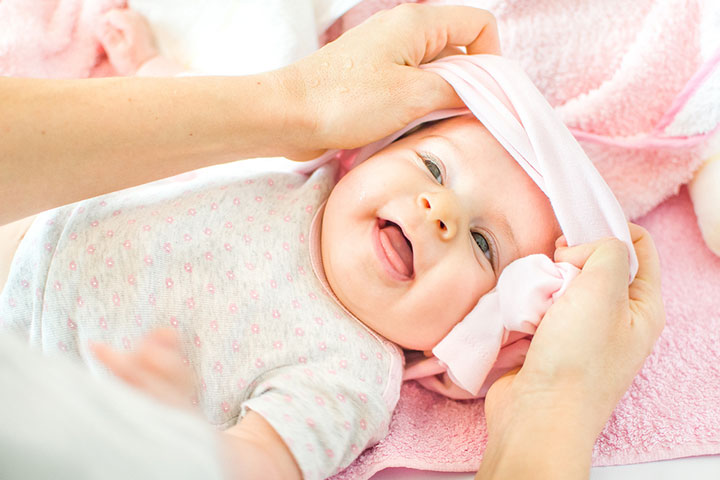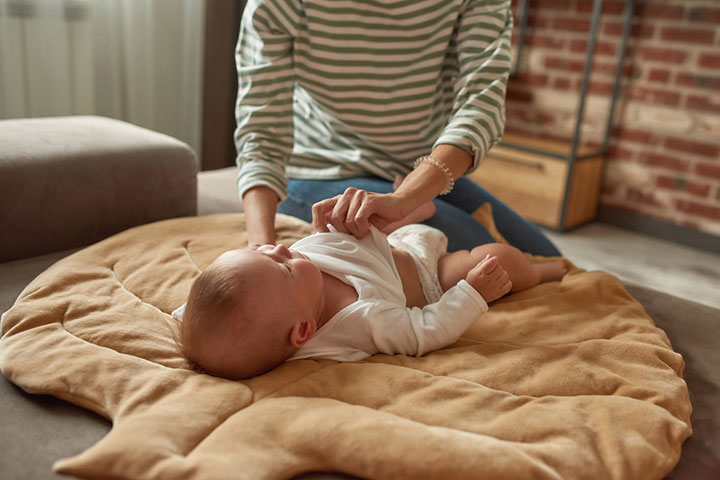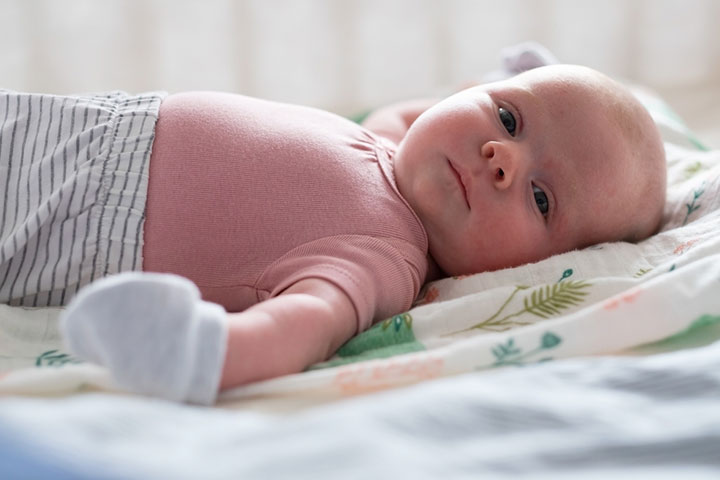
Image: Shutterstock
One of the biggest perks of having a baby is, you get to dress them up! All the days of crying over cute clothes in the baby section are over; you can finally buy them and dress your little one into a tiny watermelon onesie! Just the thought of it can give you a dopamine rush. However, once you have the little one in your arms, you might not be as confident about dressing them, as they are really tiny and fragile. It is natural to be scared of putting their little arms and legs in clothes, for fear of hurting your kid. So how would you eliminate your irrational fear of breaking your baby while dressing them up? We are here to help. Here are some detailed step-by-step instructions on how you should dress your infant the right way. Read on!
Step 1: Placement
Image: Shutterstock
- Place the infant on a secure changing table or the bed.
- Make sure you have a flat, stable surface designated for when you need to change your newborn’s clothes since they will have to be lying down.
- When your infant is tiny, you can use your lap as the changing table. Your little one may find a greater sense of safety in this.
- You might need to check the diaper too, so it’s best you keep the diaper bag, wipes, and waste bin nearby when you sit to change.
Step 2: Head
Image: Shutterstock
- Stretch the neck of the shirt or onesie so it can be pulled over the baby’s head.
- Newborns do not appreciate having anything over their shoulders and may scream or cry; it’s perfectly normal.
- If you stretch the neckline, getting your baby’s shirt on and off will be much less of a struggle.
- You can pull shirts and onesies over your baby’s head more quickly if they have buttons at the neck that you can undo.
- If you want to make dressing your baby easier, unbutton or unzip the clothing you plan to use and lay it on the changing table.
- Place your baby on the onesie and gently zip them in.
- Laying the baby on top of the pajamas, shirt, or onesie makes slipping their legs and arms through the corresponding openings simpler.
Step 3: Legs
Image: Shutterstock
- Start by dressing your baby’s feet in pajama bottoms.
- Insert your baby’s feet into their pajama bottoms before placing their arms into the sleeves.
- Button or zipper the bottom up to keep these on while you start on the sleeves.
Step 4: Arms
Image: Shutterstock
- Simply insert your infant’s hand gently through the opening in the sleeve.
- It’s not safe to force your infant’s arm into garments.
- Push your thumb, index, and middle finger through the sleeve opening and hold your baby’s hand.
- Then, carefully guide the infant’s hand through the opening.
- After getting your baby’s onesie or other clothing over their head, you should draw the fabric around their body.
- The next step is to reach your hands through the sleeve and help them out by pulling their arms through.
- Pull the clasps or zip closed.
Step 6: Zippers
Image: Shutterstock
- Once your baby’s legs and hands are safely ensconced in their clothes, you may tighten the fabric over their neck and fasten the hooks or zipper.
- Keep the buttons aligned before wearing.
- If the item of clothing has a zipper, make sure the draw is pointing away first from the baby’s face so that the baby’s skin doesn’t get caught.
- A cloth flap covers the zipper on most infant garments to keep it away from your baby’s delicate skin.
- Typically, the crotch of a onesie is where a button is located.
- To wear, one should undo the buttons at the inseam and pull the cloth down to cover the hips.
Step 7: Socks
Image: Shutterstock
- If the clothing you want to use on your infant does not have footies, be sure that you include a set of socks.
- Your newborn’s feet should always be covered.
- To save the hassle of finding socks, you can dress your infant in slacks or pajamas that already come with footies.
- Put socks on your baby’s feet if the trousers don’t have footies to keep them toasty.
- Be careful to keep an eye on your newborn’s socks to make sure those are still on.
- Baby socks that are too large might be easily kicked off.
- Legwarmers are an option to wear over your baby’s jeans to keep them toasty while you’re out in the cold.
Step 8: Gloves/Mittens
Image: Shutterstock
- Keep your infant from scratching themselves by putting thin gloves on their hands.
- Babies’ rapidly expanding fingernails can be painful, especially when they frequently scratch their faces as they play.
- Scars or even skin tears might result from your infant scratching their face.
- It’s a good idea to put thin mittens on a baby if you’ve discovered that they’re constantly scratching their face.
- Protecting your newborn’s skin with these flimsy mittens is a good idea, but remember that your child will outgrow them quickly.
So now that you know how to dress your little one correctly from head to toe dressing them on your own won’t be much of a problem. The trick is to be gentle yet confident. Newborns are usually cranky about everything happening to them and around them, so if they fuss about their new clothes or cry the moment you touch them, it’s probably them being a baby. Have fun dressing them!


















